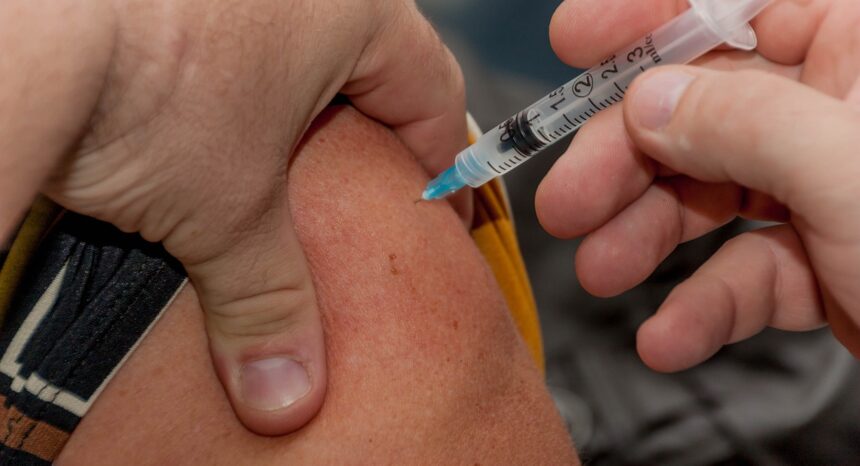A requirement that middle schoolers be vaccinated against pertussis seems to protect the wider community and encourage preteens to receive other types of inoculations.
The issue: One of the benefits of vaccination regimes is herd immunity. Even if a few people abstain from inoculation, enough are shielded to stop an outbreak from spreading. Indeed, vaccines are often called one of the greatest medical breakthroughs in history; they have saved untold millions of lives from diseases that many people today have never even imagined.
Tetanus, diphtheria and pertussis are bacterial diseases that have been fought since the 1940s with a combined vaccine known as DTaP. Thanks to DTaP, tetanus and diphtheria are rare in the United States. But pertussis – a violent and highly contagious respiratory disease also known as whooping cough – remains endemic and extremely dangerous for infants (who cannot be vaccinated with DTaP until they are 2 months old). The Centers for Disease Control and Prevention (CDC) recommends children receive five doses of DTaP by the time they are six years old. But pertussis is persistent.
In 2005, the Food and Drug Administration (FDA) approved a new vaccine, Tdap, for 11– and 12–year–olds as a booster — an extra dose to ensure the DTaP still offers protection. Since then, 46 states have mandated that adolescents receive Tdap before entering middle school.
But ensuring everyone complies has become harder in recent years, as an anti-vaccination movement has moved into the political mainstream, challenging accepted science and rendering routine vaccinations controversial. The danger became obvious during a 2015 measles outbreak traced to Disneyland.
A new paper investigates if school vaccination mandates work. In addition to the Tdap vaccine, the government-sponsored Advisory Committee on Immunization Practices at the CDC recommends 11- and 12-year-olds receive a MCV shot for meningococcal infections (such as meningitis); HPV vaccine for human papillomavirus, a common sexually transmitted disease that can cause cancer in the cervix, vagina, penis, anus, mouth and throat; and an annual vaccine for seasonal flu. But state governments require these three other vaccines less frequently.
An academic study worth reading: “Direct and Spillover Effects of Middle School Vaccination Requirements,” a working paper from the National Bureau of Economic Research, 2017.
Study summary: Christopher Carpenter and Emily Lawler, economists at Vanderbilt University, look for a relationship between the Tdap middle school mandate and the rate of pertussis deaths across the wider population. They also look for two examples of what they call spillovers: first, if more adolescents are being vaccinated, is “herd immunity” protecting more younger and older people? And second, is there “cross-vaccine spillover” — do adolescents who are required to have Tdap get other recommended vaccines as well?
The authors use data from the National Immunization Survey conducted by the CDC on teenagers between 2008 and 2013.
Key takeaways:
- Regulations that require adolescents to have the Tdap booster vaccination before entering middle school are “extremely effective” at increasing immunization and reducing pertussis in the wider population.
- By 2013, 80 percent of incoming middle school students in the U.S. had received the Tdap vaccine.
- Between 2008 and 2013, such mandates increased the likelihood that a child between the ages of 10 and 12 received the Tdap booster by 29 percent.
- Between 2008 and 2013, the authors found a 53 percent decline in pertussis cases across the entire population. Rates of death from pertussis fell for all age groups as a result of this “herd immunity” effect.
- In the 27 states where Tdap is required but MCV is not, the authors found a “cross-vaccination spillover.” Adolescents visiting the doctor for a Tdap shot appear 2.1 to 2.9 percent more likely to get the MCV while they are there.
- Overall, the Tdap requirement increased the likelihood that adolescents would begin the HPV inoculation by 4.2 to 4.9 percent and complete it by 2.5 to 3.3 percent (HPV vaccination requires two shots spaced up to a year apart). “These spillover effects are larger for children from poorer households.”
- The spillover effects for the HPV shot are highest for African-American youth and higher for Hispanic youth than white youth. Also, mothers with less education are more likely to see that their children receive the HPV vaccine compared to mothers with more education.
- The authors found no evidence that Tdap mandates encourage adolescents to receive the flu vaccine. That is possibly because the annual flu vaccine is typically available each September, after school starts.

Helpful resources:
The CDC publishes schedules of immunization recommendations for infants, children, teens and adults. The CDC also publishes recommendations specifically for Tdap vaccines with information about the dangers of pertussis.
The U.S. Department of Health and Human Services has data on pertussis infections among teenagers.
Other research:
- To establish herd immunity, the percentage of people who need to receive a vaccine varies by ailment. For measles, according to this 2000 paper published in the American Journal of Public Health, the threshold is between 93 and 95 percent.
- We profiled research about pediatricians refusing to see children who have not been vaccinated and measles outbreaks and public information.
- This 2007 article discusses the legal foundations for mandating vaccinations.
- A 2011 paper in the Journal of Health Economics estimates that a mandate to vaccinate children against chickenpox would save the economy over $23 million per year.
- A 2015 paper in Health Affairs looks at how different states’ vaccination exemption laws impact immunization rates.


Expert Commentary